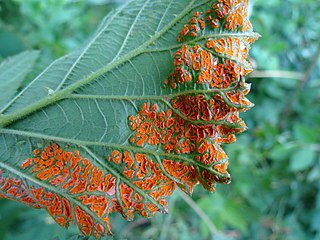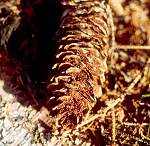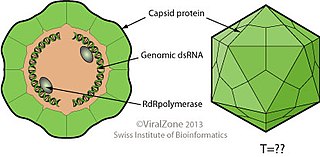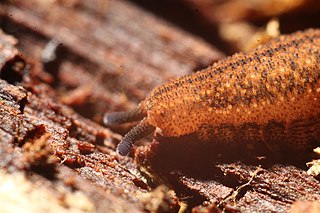
Apristurus is a genus of catsharks, the family Scyliorhinidae, commonly known as the ghost or demon catsharks.

Evodiamine is a chemical compound extracted from the plant genus Tetradium, which has been shown to reduce fat uptake in mouse studies. It is suspected that its mechanism of action is similar to that of capsaicin. As such, it has been included in some dietary supplements. Neither its fat-burning effects in humans nor any potential side effects have been empirically established.

Arthuriomyces peckianus is a fungal plant pathogen, which causes orange rust on members of the genus Rubus, and various species of berries. It is found in central and eastern North America, and Eurasia.

Naohidemyces vaccinii is a plant pathogen that affects members of the Vaccinium and Tsuga genera, causing leaf rust on lingonberries, blueberries, and cranberries, and early needle cast on hemlocks. Naohidemyces vaccinii is found on the Vaccinium genus in Canada, the United States, the United Kingdom, Europe, Russia, China, Korea, and Japan, and on hemlock in AK, ID, WA in the United States, BC in Canada, and Japan.

CYP4F11 is a protein that in humans is encoded by the CYP4F11 gene. This gene encodes a member of the cytochrome P450 superfamily of enzymes. The cytochrome P450 proteins are monooxygenases which catalyze many reactions involved in drug metabolism and synthesis of cholesterol, steroids and other lipids. This gene is part of a cluster of cytochrome P450 genes on chromosome 19. Another member of this family, CYP4F2, is approximately 16 kb away. Alternatively spliced transcript variants encoding the same protein have been found for this gene.

Bishanopliosaurus is a genus of plesiosaur. The type species is B. youngi, based on remains found in the Ziliujing Formation of China.

Pucciniastrum is a genus of Basidiomycota fungi. Pucciniastrum species, like all rust fungi, are obligate plant parasites.
Olivea is a genus of rust fungi in the family Chaconiaceae. The widespread genus contains eight species that grow on dicots, especially the tropical flowering plant family Verbenaceae.
Katsuya Toida, is a Japanese mixed martial artist. He competed in the Bantamweight and Featherweight divisions. His real name is Katsuya Toida. He is known for his judo and shoot wrestling expertise.

Megabirnaviridae is a family of double-stranded RNA viruses with one genus Megabirnavirus which infects fungi. The group name derives from member's bipartite dsRNA genome and mega that is greater genome size than families Birnaviridae and Picobirnaviridae. There is only one species in this family: Rosellinia necatrix megabirnavirus 1. Diseases associated with this family include: reduced host virulence.
Amphibacillus is a Gram-positive, spore-forming, rod-shaped and facultatively anaerobic genus of bacteria from the family of Bacillaceae. Amphibacillus have a low GC-content.

Kumbadjena is a genus of velvet worms in the family Peripatopsidae. All species in this genus are ovoviviparous, all have 15 pairs of oncopods (legs), and all are found in the southwest of Western Australia.

Pleckstrin homology domain containing, family G member 2 (PLEKHG2) is a protein that in humans is encoded by the PLEKHG2 gene. It is sometimes written as ARHGEF42, FLJ00018.
Kabatiella is a genus of fungi belonging to the family Saccotheciaceae.

Melampsorella is a genus of fungi belonging to the family Pucciniastraceae.

Melampsoridium is a genus of fungi belonging to the family Pucciniastraceae.

Milesina is a genus of fungi belonging to the family Pucciniastraceae.

Ochropsora is a genus of fungi belonging to the family Uropyxidaceae.
Sato's beaked whale is a little-known species of four-toothed whale.













